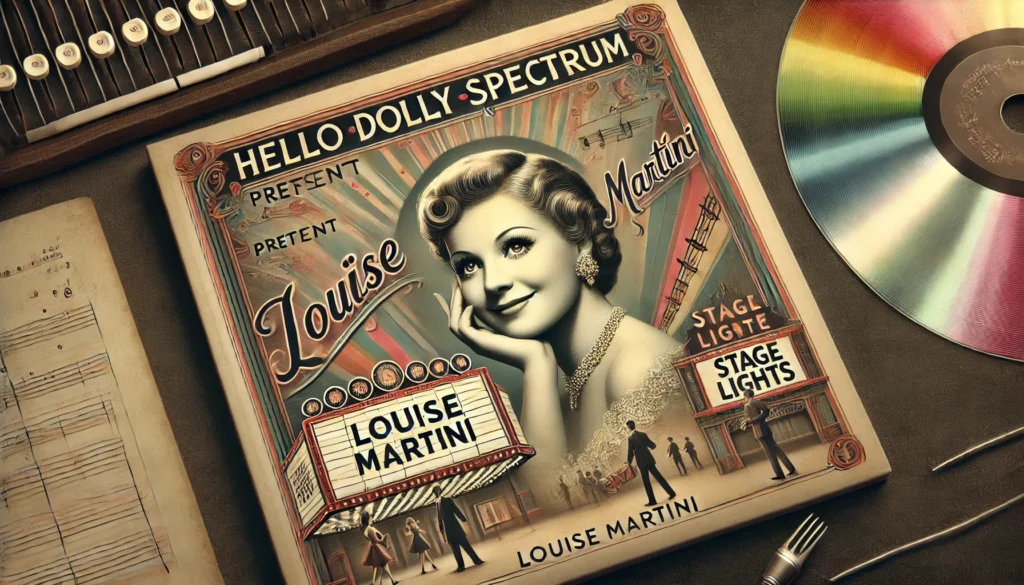Introduction
“Hello, Dolly!” is one of the most iconic musicals in the history of theater, captivating audiences worldwide with its humor, romance, and unforgettable music. The German-language adaptation, famously titled “Hello Dolly Spectrum Präsentiert Louise Martini,” brings a fresh perspective to this timeless classic. This article provides an in-depth exploration of the album, its background, and its enduring impact on musical theater.
The Story of “Hello, Dolly!”
Originally a Broadway production that premiered in 1964, “Hello, Dolly!” was based on Thornton Wilder’s play “The Matchmaker.” The musical follows the adventures of Dolly Levi, a vivacious matchmaker, as she navigates romance, ambition, and the complexities of relationships. Its rich blend of comedy, drama, and stunning musical numbers quickly made it a sensation.
When “Hello, Dolly!” was adapted for German audiences, the vibrant storytelling was preserved, but it gained unique characteristics through translation and performance by German artists, making it a gem for fans of international theater.
Louise Martini: The Star of the German Adaptation
A Biography of Louise Martini
Louise Martini, a renowned Austrian actress and singer, became a household name through her stage performances and recordings. Born in Vienna, her career spanned decades, showcasing her versatility and charisma. As Dolly Levi, Martini brought charm and depth to the character, captivating listeners with her emotive voice and magnetic presence.
Martini’s Contribution to “Hello, Dolly!”
Martini’s portrayal of Dolly Levi in the German adaptation was a standout, blending humor with sophistication. Her performance not only elevated the production but also solidified her status as a leading figure in German musical theater. The album “Spectrum Präsentiert Louise Martini” immortalized her role, leaving a legacy cherished by fans.
Detailed Track Analysis
The German recording of “Hello, Dolly!” features 13 tracks, each uniquely adapted to resonate with German-speaking audiences. Below is a detailed breakdown of the album’s tracks:
| Track No. | Title | Artist(s) | Duration |
|---|---|---|---|
| 1 | Orchester – Hello Dolly | Orchestra | 1:19 |
| 2 | Ich schubs ein bisschen hier | Louise Martini | 3:02 |
| 3 | Man braucht ein Frauchen | Roy Black, René Kollo, Willy Millowitsch | 2:35 |
| 4 | Zieh’ deinen Sonntagsanzug an | Roy Black, René Kollo, Adolf Martell | 4:56 |
| 5 | Bänder trag’ ich hinten dran am Hut | Brigitte Petry | 2:50 |
| 6 | Mutterschaftsmarsch | Louise Martini, Brigitte Petry | 1:53 |
| 7 | Ich tanze | Roy Black, René Kollo, Willy Millowitsch, Josef Petrak | 3:46 |
| 8 | Ich lass’ die Musik nicht vorbei | Louise Martini | 3:33 |
| 9 | Eleganz | Roy Black, René Kollo, Josef Petrak | 2:24 |
| 10 | Hello Dolly | Louise Martini | 5:16 |
| 11 | Es kann oft ein Moment sein | René Kollo, Willy Millowitsch, Brigitte Petry | 3:37 |
| 12 | Lebwohl, Liebling | Louise Martini | 2:38 |
| 13 | Hello Dolly (Finale) | René Kollo, Louise Martini, Willy Millowitsch | 4:29 |
This tracklist highlights the blend of orchestral brilliance and vocal artistry that makes the album a must-listen.
Reception and Legacy
Upon its release, “Hello Dolly Spectrum Präsentiert Louise Martini” was met with critical acclaim. Audiences praised the adaptation’s ability to maintain the charm of the original while offering a distinctly German flavor. Over the years, it has become a collector’s item, symbolizing the golden era of musical adaptations.
Availability and Collectibility
The album remains available through select platforms, including online marketplaces and specialty music shops. Collectors value it for its rarity and historical significance, making it a prized addition to any musical theater enthusiast’s collection.
Comparisons with Other Adaptations
The German version of “Hello, Dolly!” stands out for its linguistic and cultural nuances. Unlike other recordings, this adaptation seamlessly integrates German idioms and humor, making it a unique experience. The performances, particularly by Louise Martini, add a layer of authenticity and charm not found in other versions.
FAQs
What year was the German adaptation of “Hello, Dolly!” released?
The German adaptation was released in 1967.
Who are the other notable performers on the album?
René Kollo, Willy Millowitsch, and Roy Black also contributed to the album.
Where can I purchase “Hello Dolly Spectrum Präsentiert Louise Martini”?
The album is available on platforms like Amazon and specialty music stores.
How does the German adaptation differ musically from the original?
The German version features localized lyrics and a slightly different orchestral arrangement to suit German audiences.
Why is Louise Martini’s performance so celebrated?
Martini’s charismatic portrayal of Dolly Levi brought warmth and depth to the character, making her performance unforgettable.
Conclusion
“Hello Dolly Spectrum Präsentiert Louise Martini” remains a landmark in musical theater history. By blending the timeless appeal of “Hello, Dolly!” with German cultural elements, it offers a unique listening experience. Louise Martini’s exceptional performance continues to resonate, making this adaptation a cherished piece of musical heritage. Whether you’re a longtime fan or new to the world of musical theater, this album is a treasure worth exploring.

Recommended Articles:
Z Supply: Easy Going Cotton Slub Dress – Your Ultimate Style Guide
Ultimate Guide to 31435-20000 Kia Kefico 9 410 930 304
The Ultimate Guide to “The Fly Fishing Log” (ISBN 8573345727)
The Ultimate Guide to the Top Tier Beanie – Style, Quality & Tips
Hello Dolly Spectrum Prasentiert Louise Martiini – Everything You Should Know





